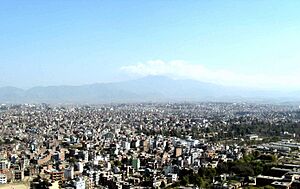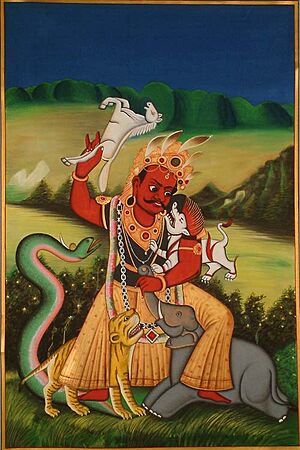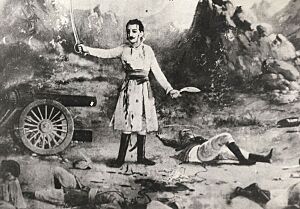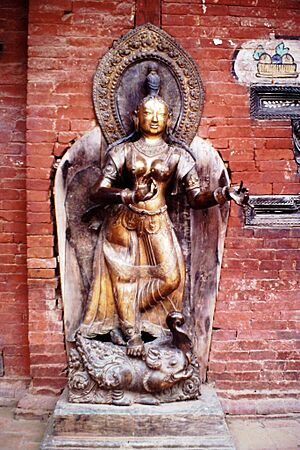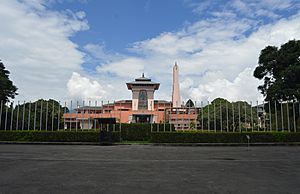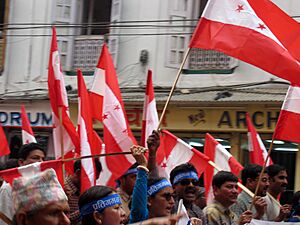History of Kathmandu facts for kids
The city of Kathmandu has a long and exciting history, deeply connected to the entire Kathmandu valley. Its story goes back to very old times.
Contents
- Ancient Kathmandu Valley: Early Days
- Licchavi Kingdom: A Time of Growth (400–750 AD)
- Kathmandu in the 7th and 8th Centuries
- Kathmandu's Transition (750–1200)
- Malla Dynasty: Art and Challenges (1200–1768)
- Unification and Conflicts (1769–1845)
- Modern History: Changes and Challenges (1846–1999)
- Contemporary History: Recent Times (2000–Present)
- Images for kids
- See also
Ancient Kathmandu Valley: Early Days
Scientists have found clues that Kathmandu and its nearby towns are very old, possibly from between 167 BC and 1 AD. Digs in places like Hadigaon and Lubhu in Kathmandu have uncovered old brick walls and even Stone Age tools.
In 1992, workers found a large stone statue in Maligaon, eastern Kathmandu. This statue, made in the style of the Kushan Empire, is of a standing man. An inscription on it dates back to around 185 AD. This makes it the oldest known writing found in the Kathmandu Valley, showing that kings ruled here much earlier than we thought!
Long ago, the Kathmandu Valley was a big lake! A Buddhist saint named Manjushree Bodhisattva is said to have drained this lake. He cut open a path through the Chobar gorge on the Bagmati River, letting the water flow out. This created a fertile valley where people could farm and build homes. Manjushree also built a city called Manjupatan, which is now part of modern Kathmandu. He even chose his student, Dharmakarma, to rule it.
Early rulers included the Abhir dynasty, followed by the Kiratis, who came from the northeastern hills of India around 700 BC. They had 29 rulers before the Lichhavis took over. Four stupas (Buddhist monuments) near Patan, built by a princess named Charumati, also show how old the valley's history is.
Licchavi Kingdom: A Time of Growth (400–750 AD)
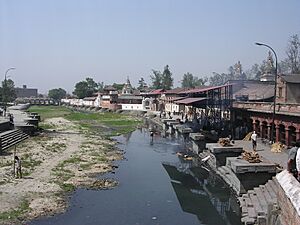
During the time of the Licchavis, Kathmandu was formed from two smaller settlements: Yambu (meaning "northern land") and Yangal (meaning "southern land"). The Licchavi king Gunakamadeva founded a new city between them, on the banks of the Bishnumati River. He called it Kantipur.
The city was designed to look like Manjushree's sword, as mentioned in old stories. It was protected by eight barracks, guarded by goddesses called Ajimas. Legend says King Gunakamadeva dreamed that the goddess Laxmi (also called Kanti) asked him to build a city in her name, so he named it Kantipur. To bring the people of Yembu and Yengal together, the king started a festival. This festival, where the Majipa Lakhey and Pulukishi dances are performed, is still celebrated today as Yenya or Indra Jatra.
A marketplace was set up in the center of Kantipur. A temple for Bhimsen, the god of merchants, was built there to attract traders. This new, safe city helped trade grow between India and China, making the city richer and bringing together many different people, religions, and cultures.
The Licchavis came to Nepal from Bihar, India. They defeated the last Kirat King, Gasti, and took control. There were 48 Licchavi rulers. One of the most famous was Mana Deva I, who ruled from 464 AD. He loved art and building. He brought the pagoda-style roof to buildings and created beautiful sculptures. Many famous temples and structures, like the Changunarayan Temple, the reclining Vishnu of Budhanilkantha, and parts of the Pashupatinath Temple, are credited to him.
Kathmandu in the 7th and 8th Centuries
A famous Chinese Buddhist monk named Xuanzang wrote about Nepal around 637-642 CE. He described the capital city (Kathmandu) as being about 8 km around, surrounded by mountains and valleys. He noted that both Buddhists and Hindus lived together peacefully, with many monasteries and temples. The king, a Kshattriya from the Licchava family, was wise and believed in Buddha's teachings. Xuanzang also mentioned a king named Aṁśuvarman, who was very smart and wrote a book on sounds.
Later, Chinese records from the Tang Annals described King Narendradeva of Nepal. They said he wore beautiful jewels and sat on a lion-throne. His palace had a seven-story tower with copper roofs and golden dragon spouts that looked like fountains. These records also mentioned that Narendradeva's father had lost his throne but was helped by the Tibetans to get it back, which made Nepal connected to Tibet.
Another old Buddhist text from 650 CE described a huge seven-story building in the capital, over 60 meters high, with beautiful carvings and precious stones. It could hold many people. There was also a Buddhist monastery on a hill south of the city.
After Narendradeva, King Śivadeva II ruled. Even though he was Hindu, he supported Buddhism. His son, Jayadeva II, followed him. Many inscriptions from their reigns tell us about this period, leading up to King Rāghadeva in 879 CE.
Kathmandu's Transition (750–1200)
This period was a time of change in the Kathmandu Valley, though not many detailed records exist. Around the late 900s, King Gunakama Deva is said to have formally established Kathmandu (Kantipur) where the Bishnumati and Bagmati rivers meet. He merged the older settlements of Yambu and Yangal into the new city.
The city was still shaped like Manjushree's sword, with temples dedicated to eight mother goddesses (Ajima) marking its edges. Important buildings like the Kasthamandap were built, surrounded by temples and narrow streets with tall houses. The old royal palace complex was in the center. Water spouts, like Thanhiti, provided drinking water to the people.
Malla Dynasty: Art and Challenges (1200–1768)
The Malla dynasty ruled Kathmandu Valley from 1200 to 1768. Famous Malla kings included Arimalla, Jayasthitimalla, and Yakshamalla. This was a golden age for art and culture in Kathmandu. They built many beautiful pagodas, houses with detailed carved windows, and lovely open-air shrines with amazing sculptures. Kathmandu grew into a large city. A missionary in the 1760s noted that "Catmandu" had about 18,000 houses.
However, the Malla kingdom faced many attacks. In 1312, King Ripumalla raided the valley. In 1345–46, Sultan Shams ud-din Ilyas of Bengal invaded, causing a lot of damage and forcing the city to be rebuilt. In 1484, the Malla kingdom split into three smaller kingdoms: Kathmandu, Bhaktapur, and Patan.
The House of Gorkha began to rise in 1559. Kings like Ram Shah (1606-1633) started expanding the Gorkha kingdom. Later, King Jitamitra Malla of Bhaktapur (1673-1696) was famous for his building projects. He built temples, palaces like the Dharmasala Palace, and added beautiful decorations to existing structures. His son, Bhupatindra Malla, continued this work.
Unification and Conflicts (1769–1845)
After Jayayakshya Malla expanded the Malla kingdom, he divided it among his sons to rule more easily. This created a confederation of Malla states. While they focused on trade and art, their army wasn't as strong.
In 1743, Prithvi Narayan Shah became king of Gorkha. He wanted to unite Nepal. He first attacked Kirtipur, but the Malla armies defeated him. However, by 1769, Prithvi Narayan Shah had conquered Kathmandu, Patan, and Bhaktapur. This created the foundation for the modern Kingdom of Nepal. He died in 1775.
In 1767, the Malla kings asked the British for help against the Gorkhas. A British expedition was sent, but it failed due to illness and poor preparation. This made the Gorkhas suspicious of the British.
The Gorkha armies continued to expand, taking over eastern Nepal, parts of Sikkim, and lands to the west. However, their raids into Tibet led to a conflict with the Chinese emperor. In 1792, a large Chinese army pushed the Nepalese back almost to Kathmandu. Nepal had to sign a treaty, losing trade rights in Tibet and agreeing to pay tribute to China every five years.
Border disputes also grew between the Gorkhas and the British East India Company, especially over the fertile Tarai region. This led to the Anglo-Nepalese War from 1814 to 1816. After some battles, the Gorkhas were forced to sign the Sugauli Treaty in 1816. Nepal lost Sikkim, Kumaon, Garhwal, and much of the Tarai. The British also placed a "Resident" in Kathmandu, which made Nepal feel less independent.
Modern History: Changes and Challenges (1846–1999)
After the Shah kings took over, a period of strong rule by the Rana family began. Jang Bahadur Kunwar became the first Rana Prime Minister in 1846. The Ranas held all the real power until 1950, while the Shah kings were mostly figureheads. The Ranas kept Nepal isolated from the outside world and controlled everything, supported by the army.
The Nepali Congress Party was formed in 1946. In 1948, Nepal got its first constitution, but it was soon suspended. By 1950, the Ranas had a conflict with King Tribhuvan, who then sought safety in India. Many government troops and Ranas joined those who wanted change. During this time, Nepal signed peace and trade treaties with India.
The 1934 Nepal–Bihar earthquake caused a lot of damage to Kathmandu, but the city was later rebuilt. From the 1980s, Kathmandu started to grow rapidly, with farmlands turning into new buildings and high-rises.
In January 1951, the power shifted back to the Shah monarchy. The Ranas had to give up their power, and King Tribhuvan returned to the throne. Local elections were held in Kathmandu in 1953. The Communist Party of Nepal won many seats, and their candidate, Janak Man Singh, became chairman. However, he was later removed from office due to a dispute with the national government.
After King Tribhuvan died in 1955, King Mahendra took over. Nepal joined the United Nations, and new embassies opened. A new constitution was created in 1959, and the first general elections were held. The Tribhuvan University was also founded.
In 1960, King Mahendra ended the multi-party democracy and introduced the Panchayat system, which was controlled by the monarchy. This system was meant to be democratic but was really controlled by the king. Political unrest continued, and in 1971, a new trade treaty was signed with India.
In 1972, King Mahendra died, and King Birendra became king. A big fire burned down Singha Durbar, the seat of government, that same year. In 1980, a public vote supported keeping the Panchayat system. However, demonstrations for democracy grew, and in 1990, the king brought back multi-party democracy. A new constitution was made, and elections were held in 1991.
Contemporary History: Recent Times (2000–Present)
Recent years have been challenging for Kathmandu, with political instability and protests. On June 1, 2001, a terrible event known as the royal massacre happened at the Narayanhiti Royal Palace. Crown Prince Dipendra shot his family, including his father King Birendra and mother Queen Aishvarya, before turning the gun on himself. The reason for this tragedy is still debated, but it is thought to be related to his desire to marry a girl his parents did not approve of. After this, King Gyanendra, King Birendra's brother, became king.
In April 2004, a large crowd protested the killing of 12 Nepalese job seekers in Iraq. They burned and damaged many buildings in the city. Since 2008, Kathmandu has seen many political protests. In November 2009, Communist Party of Nepal (Maoist) rebels protested against the government, causing traffic problems and demanding changes.
In April 2015, a powerful 7.8 magnitude earthquake severely damaged Kathmandu. Many buildings were destroyed or harmed. Some have been rebuilt, while others are still being repaired.
Today, Kathmandu is seeing a boom in construction, with many new high-rise apartment complexes being built to meet demand.
Images for kids
See also
- Battle of Kathmandu
- Battle of Kirtipur
- Battle of Lalitpur
- Battle of Bhaktapur
- Timeline of Kathmandu


